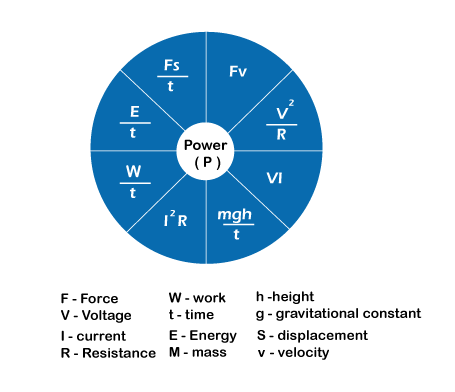Power FormulaPower is defined as the amount of work done per unit time. Power is required everywhere to perform a task, be it physically or mechanically. The concept remains the same, i.e., the ability required to complete a task at a specific time. Characteristics of powerThe characteristics of power are as follows:
We can define the power formula as mechanical power, gravitational power, electric power, and power in terms of force, displacement, and velocity. It is given below: 
Let's discuss the various power formulas. Mechanical powerIt is defined as the energy of a system per unit time. P = E/t Where, P is the power E is the energy T is the time The watt, joules, and second are the unit of power, energy, and time. Power is also expressed as: P = w /t Where, W is the work done, t is the time, and P is the power. Gravitational powerIt is measured with respect to g, which is the gravitational constant with the value of 9.8 meters per Second Square. The gravitational power is expressed as: P = mgh / t Where, P is the power m is the mass h is the height t is the time Mass is generally measured in Kilograms, and height in meters. Electrical powerThe electrical power is expressed as: P = V I Where, P is the power V is the voltage I is the current Electric power is defined as the product of the current and the potential across the circuit. According to Ohm's law, I = V/R Where, I is the current R is the resistance measured in Ohms V is the voltage Substituting the value of I in the given power formula, we get: P = V x I P = V x (V/R) P = V^2/R Or P = V x I P = (IR) x I P = I^2R Power in terms of force, displacement, and velocityIt is expressed as: Power = Force x Displacement/ Time P = Fs/t Where, F is the force measured in Newton S is the displacement measured in meter T is the time We can also write the above equation as: P = Force x velocity P = Fv (As velocity = displacement/time) Let's discuss numerical examples and MCQs on power for better understanding. Numerical examplesConsider the following examples. Example 1: An electric machine uses the energy of 200J in 10 seconds. Find the power used by the machine? Solution: The given parameters are: E = 200J T = 10s The power is given by: P = E/t P = 200/10 = 20W Thus, the power required by the machine is 20 Watts. Example 2: Henry has of mass of 50 kg and runs upto 10m high in 20 seconds. Find the power. Solution: The given parameters are as follows: Mass = 50 kg Height = 10m Time = 20 seconds The gravitational power can be computed as P = mgh/t Where, g = 9.8 meter per second square P = 50 x 9.8 x 10 / 20 P = 245 Watts Thus, the power is 245 watts. Example 3: The voltage and current of the electrical circuit are given as 15V and 2A. Find the electric power of the circuit. Solution: The given parameters are as follows: Voltage = 15 Volts Current = 2 Ampere P = V x I P = 15 x 2 = 30 Watts Thus, the power of the electrical circuit is 30 watts. Example 4: A constant force of 10N is applied on an object moving at a constant velocity of 4 m/s. Compute the power. Solution: The given parameters are as follows: Force = 10N Velocity = 4m/s Power can be computed as, P = Force x velocity P = 10 x 4 = 40 Watts Thus, the power is 40 watts. Example 5: Find the power of the electrical circuit with a resistance of 2 Ohms and the current of 3A. Solution: The given parameters are as follows: Resistance = 2 Ohms Current = 3 Ampere P = I^2R P = 3 x 3 x 2 P = 18 Watts Thus, the power is 8 watts. Multiple Choice Questions on powerThe MCQs based on power formula are as follows: 1) Which one of the following is a correct power formula?
Answer: (b) Power = energy / time Description: The correct formula of power from the above option is P = E / t. 2) S.I. unit of power is:
Answer: (d) Watt Description: According to the International System of Units, the unit of power is Watt. 3) The name of the device used to measure power is:
Answer: (c) Wattmeter Description: Wattmeter is generally used to measure the electric power in the circuit. 4) Kilowatt-hour is a unit of?
Answer: (c) Energy Description: Power = energy / time So, energy = power x time Energy = kilowatt x hour = Kilowatt-hour Here, kilowatt and hour is the unit of power and time. 5) Power is directly proportional to:
Answer: (c) Both (a) and (b) Description: The formula of power is I^2R or V^2/R. It means that power is directly proportional to both voltage and current.
Next TopicElectronic Components
|
 For Videos Join Our Youtube Channel: Join Now
For Videos Join Our Youtube Channel: Join Now
Feedback
- Send your Feedback to [email protected]
Help Others, Please Share










